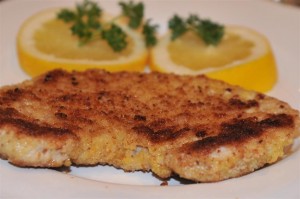
The Wiener Schnitzel is the most popular meat dish known in other countries. Very interesting is its origin. Wiener Schnitzel comes originally from Austria and the name is protected by law and it has to be cooked with veal.
In Germany we enjoy it a lot with pork instead of veal, and in this case it is called “Schnitzel Wiener Art”, or “Wiener Schnitzel vom Schwein” (in Austria) to differentiate it from the original.
Some say it is not originally from Austria; it is from the Northern Italian city Milan, and called “cotoletta alla milanese”. But on the other side others say it appeared in Vienna during the 15th or 16th century. And according to another hypothesis, it was introduced in 1857 by the famous Field Marshal Radetzky, who spent much of his life in Milan. So he might have it found in Milan.
The below recipe can be done either with veal or pork, and serves 2 people. The photo shows the Wiener Schnitzel with pork.
Find more German recipes on www.MyBestGermanRecipes.com
Ingredients Wiener Schnitzel
• 2 pieces veal or pork (1/2 – 3/4 inches thick)
• 1 egg
• flour
• salt, pepper
• bread crumbs (without any salt or any spices, the best is to make your own, see below)
• lemon, parsley
• clarified butter, or lard for frying
• kitchen paper
Cooking Instructions Wiener Schnitzel
How to make the “Panade” – this is the German word for the bread crumb mix:
You need older bread, preferably German style buns, French baguette or ciabatta. The bread should be very dry and still eatable . Grate the old bread and keep it in a jar.
1. Add salt (and/or pepper) to the meat on both sides.
2. Turn the slices in flour, hold them vertically up and slightly beat both sides with the fingertips; this is the way how to get rid of too much flour. There should be only a very thin layer of flour on the meat
3. In a deeper dish beat an egg and on a flat plate have the breadcrumbs.
4. Turn both sides of the Schnitzel first in the egg, let it drip, than in the bread crumbs with boths sides.
5. Press them slightly so the crumbs are not sticking too much on the Schnitzel.
6. Bake them right away; if you don’t do this they will get moist which means the panade will be ruined.
7. In a skillet fry ghee or lard (as the old Austrian school is demanding lard); add so much that the meat is swimming in it (2-3 tbso ghee).
8. After the first side is fried, turn it; rattle the pan several times so that the lard is being in contact with the upper side of the panade.
The secret is that the panade should not be sticking along the meat. Make this test: You should be able to push a flat knife through meat and panade; there should be a gap between meat and panade.
9. After being fried, melt butter in a separate skillet until it is foamy, roll the Schnitzel in the butter (adds the authentic taste).
10. After the meat is done put the Schnitzel on kitchen paper and pat it so all lard or ghee will be removed; it should not be greasy at all.
Wiener Schnitzel is never served with or in gravy. This would be like a crime! You serve it always with a little bunch of parsley and a slice of lemon. That’s all. Are you ready to try it out?
Best side dishes: Mixed salad (lettuce, potato salad and carrots); mashed potatoes or French fries (a potato side dish would be the best combination).
So Good, We LOVE them and will be fixing them again very soon!!!!!
So Good, We LOVE them and will be fixing them again very soon!!!!!
Wiener Schnitzel is definitely a Viennese dish and it can be prepared in Vienna from veal or pork. So I do not see that as a typical German food – but than I may be biased being that I am Viennese and offer Viennese cuisine on tours to Vienna.
Wiener Schnitzel is definitely a Viennese dish and it can be prepared in Vienna from veal or pork. So I do not see that as a typical German food – but than I may be biased being that I am Viennese and offer Viennese cuisine on tours to Vienna.